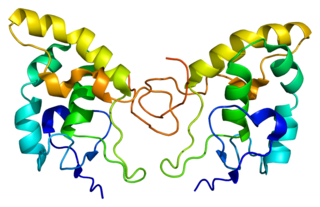
Axin-1 is a protein that in humans is encoded by the AXIN1 gene.

Frizzled-8(Fz-8) is a protein that in humans is encoded by the FZD8 gene.

Frizzled-9(Fz-9) is a protein that in humans is encoded by the FZD9 gene. Fz-9 has also been designated as CD349.

Leucine-rich repeat-containing G-protein coupled receptor 5 (LGR5) also known as G-protein coupled receptor 49 (GPR49) or G-protein coupled receptor 67 (GPR67) is a protein that in humans is encoded by the LGR5 gene. It is a member of GPCR class A receptor proteins. R-spondin proteins are the biological ligands of LGR5. LGR5 is expressed across a diverse range of tissue such as in the muscle, placenta, spinal cord and brain and particularly as a biomarker of adult stem cells in certain tissues.

Secreted frizzled-related protein 1, also known as SFRP1, is a protein which in humans is encoded by the SFRP1 gene.

Low-density lipoprotein receptor-related protein 6 is a protein that in humans is encoded by the LRP6 gene. LRP6 is a key component of the LRP5/LRP6/Frizzled co-receptor group that is involved in canonical Wnt pathway.

Autocrine motility factor receptor, isoform 2 is a protein that in humans is encoded by the AMFR gene.

Ubiquitin-conjugating enzyme E2 D1 is a protein that in humans is encoded by the UBE2D1 gene.

Ubiquitin-conjugating enzyme E2 D2 is a protein that in humans is encoded by the UBE2D2 gene.

Axin-2, also known as axin-like protein (Axil), axis inhibition protein 2 (AXIN2), or conductin, is a protein that in humans is encoded by the AXIN2 gene.

E3 ubiquitin-protein ligase RNF216 is an enzyme that in humans is encoded by the RNF216 gene.

Ubiquitin/ISG15-conjugating enzyme E2 L6 is a protein that in humans is encoded by the UBE2L6 gene.

E3 ubiquitin-protein ligase RNF5 is an enzyme that in humans is encoded by the RNF5 gene.

The human gene UBR1 encodes the enzyme ubiquitin-protein ligase E3 component n-recognin 1.

RING finger protein 11 is a protein that in humans is encoded by the RNF11 gene.

E3 ubiquitin-protein ligase RNF14 is an enzyme that in humans is encoded by the RNF14 gene.

E3 ubiquitin-protein ligase NRDP1 is an enzyme that in humans is encoded by the RNF41 gene.

RING finger protein 115 is a protein, that in humans, is encoded by the RNF115 gene.

E3 ubiquitin-protein ligase RNF125 is an enzyme that in humans is encoded by the RNF125 gene.

Ring finger protein 167 is a protein that in humans is encoded by the RNF167 gene.



















